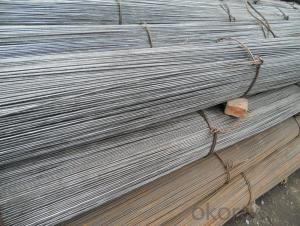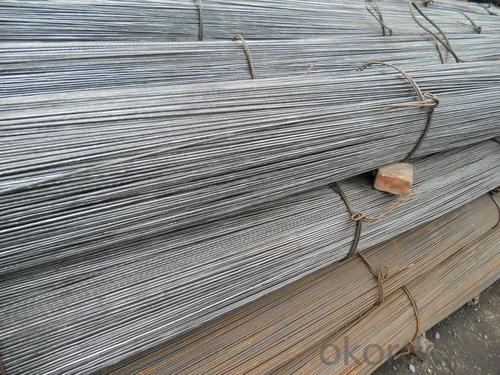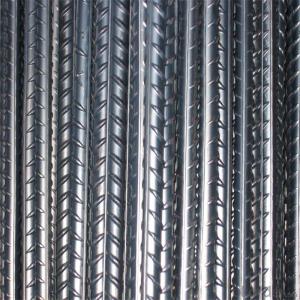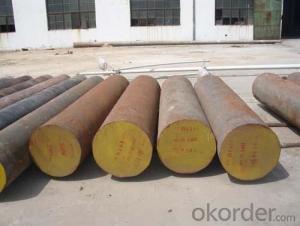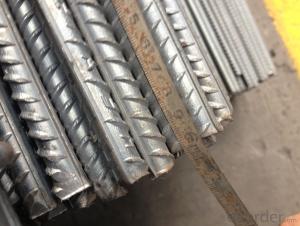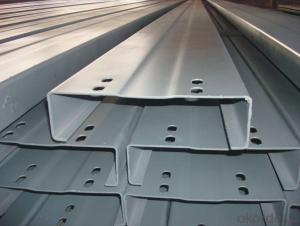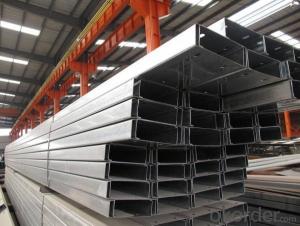KS Steel Deformed Bar SD400 Made in China
- Loading Port:
- Tianjin
- Payment Terms:
- TT or LC
- Min Order Qty:
- 24 m.t.
- Supply Capability:
- 18000 m.t./month
OKorder Service Pledge
OKorder Financial Service
You Might Also Like
Product Description:
OKorder is offering KS Steel Deformed Bar SD400 Made in China at great prices with worldwide shipping. Our supplier is a world-class manufacturer of steel, with our products utilized the world over. OKorder annually supplies products to European, North American and Asian markets. We provide quotations within 24 hours of receiving an inquiry and guarantee competitive prices.
Product Applications:
KS Steel Deformed Bar SD400 Made in China are ideal for structural applications and are widely used in the construction of buildings and bridges, and the manufacturing, petrochemical, and transportation industries.
Product Advantages:
OKorder's KS Steel Deformed Bar SD400 Made in China are durable, strong, and resist corrosion.
Main Product Features:
· Premium quality
· Prompt delivery & seaworthy packing (30 days after receiving deposit)
· Corrosion resistance
· Can be recycled and reused
· Mill test certification
· Professional Service
· Competitive pricing
Product Specifications:
Standard | GB | HRB400 | ||||||||
Diameter | 6mm,8mm,10mm,12mm,14mm,16mm,18mm,20mm, 22mm,25mm,28mm,32mm,36mm,40mm,50mm | |||||||||
Length | 6M, 9M,12M or as required | |||||||||
Place of origin | Hebei, China mainland | |||||||||
Advantages | exact size, regular package, chemical and mechanical properties are stable. | |||||||||
Type | Hot rolled deformed steel bar | |||||||||
Brand name | DRAGON | |||||||||
Grade | Technical data of the original chemical composition (%) | |||||||||
C | Mn | Si | S | P | V | |||||
HRB400 | ≤0.25 | ≤1.60 | ≤0.80 | ≤0.045 | ≤0.045 | 0.04-0.12 | ||||
Physical capability | ||||||||||
Yield Strength (N/cm²) | Tensile Strength (N/cm²) | Elongation (%) | ||||||||
≥400 | ≥570 | ≥14 | ||||||||
Packaging & Delivery:
Packaging Detail: products are packed in bundle and then shipped by container or bulk vessel, deformed bar is usually naked strapping delivery, when storing, please pay attention to moisture proof. The performance of rust will produce adverse effect.
Each bundle weight: 2-3MT, or as required
Payment term: TT or L/C
Delivery Detail: within 45 days after received advanced payment or LC.
Label: to be specified by customer, generally, each bundle has 1-2 labels
Trade terms: FOB, CFR, CIF
FAQ:
Q1: Why buy Materials & Equipment from OKorder.com?
A1: All products offered byOKorder.com are carefully selected from China's most reliable manufacturing enterprises. Through its ISO certifications, OKorder.com adheres to the highest standards and a commitment to supply chain safety and customer satisfaction.
Q2: How do we guarantee the quality of our products?
A2: We have established an advanced quality management system which conducts strict quality tests at every step, from raw materials to the final product. At the same time, we provide extensive follow-up service assurances as required.
Q3: How soon can we receive the product after purchase?
A3: Within three days of placing an order, we will begin production. The specific shipping date is dependent upon international and government factors, but is typically 7 to 10 workdays.
Images:
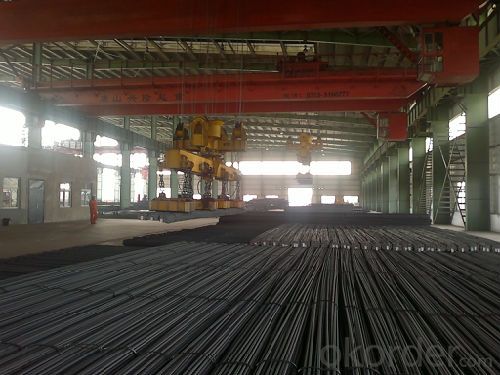
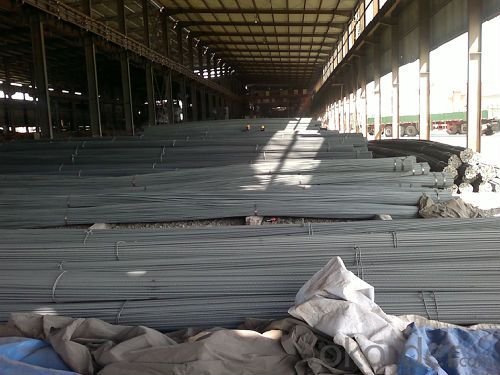
- Q: Can steel rebars be used in pre-tensioned concrete structures?
- No, steel rebars cannot be used in pre-tensioned concrete structures. Pre-tensioned concrete structures rely on the use of high-strength tendons made of materials such as high-strength steel or carbon fiber reinforced polymers (CFRP) to apply tension to the concrete before it cures. This pre-tensioning process helps in enhancing the structural strength and load-bearing capacity of the concrete elements. Steel rebars, on the other hand, are used in reinforced concrete structures where they provide additional strength to resist tensile forces.
- Q: What is the role of steel rebars in preventing concrete spalling?
- The role of steel rebars in preventing concrete spalling is to provide reinforcement and strength to the concrete structure. When concrete is reinforced with steel rebars, it can better resist the forces that cause spalling such as expansion and contraction due to temperature changes, moisture penetration, and structural loads. The rebars help distribute stress and prevent cracking, which in turn reduces the likelihood of spalling occurring.
- Q: What are the different types of steel rebars used in underground constructions?
- Underground constructions commonly employ various types of steel rebars, each serving a specific purpose. These rebars fortify concrete structures, enhancing their durability and strength. 1. Carbon Steel Rebars: The most prevalent kind of rebar used underground is carbon steel rebars. They boast high tensile strength due to their composition of carbon steel, rendering them suitable for diverse applications. 2. Epoxy-Coated Rebars: Carbon steel rebars receive an epoxy coating, transforming them into epoxy-coated rebars. This protective layer makes them resistant to corrosion, rendering them ideal for underground constructions where moisture and chemicals are present. 3. Stainless Steel Rebars: Stainless steel rebars offer exceptional resistance to corrosion and possess excellent strength properties. They are commonly employed in underground constructions that anticipate extreme environmental conditions, such as high humidity or exposure to saltwater. 4. Galvanized Rebars: Carbon steel rebars undergo a zinc coating process, resulting in galvanized rebars. This coating enhances their corrosion resistance, making them suitable for underground constructions situated in areas with elevated moisture levels or exposure to chemicals. 5. Fiberglass Rebars: Fiberglass rebars consist of glass fibers embedded within a resin matrix. They are lightweight, corrosion-resistant, and possess high tensile strength. Fiberglass rebars are frequently utilized in underground constructions that necessitate non-magnetic properties, such as proximity to sensitive equipment or areas susceptible to electromagnetic interference. The selection of a specific type of steel rebar for an underground construction project is based on its unique advantages and the project's specific requirements. Factors such as environmental conditions, load-bearing capacity, and anticipated lifespan are carefully considered when determining the appropriate steel rebar for a particular application.
- Q: What are the guidelines for using steel rebars in pre-stressed or post-tensioned concrete elements?
- The guidelines for using steel rebars in pre-stressed or post-tensioned concrete elements include ensuring the rebars meet the required specifications and standards for strength, size, and corrosion resistance. They should be properly anchored and positioned within the concrete element according to the design specifications. Additionally, care should be taken to avoid damaging or stressing the rebars during the construction process, and proper curing and protection measures should be implemented to prevent corrosion and ensure the longevity of the structure.
- Q: How are steel rebars protected from concrete spalling?
- Steel rebars are protected from concrete spalling through the use of two main methods: epoxy coating and concrete cover. Epoxy coating is applied to the rebars to prevent direct contact with the concrete, forming a protective layer that prevents corrosion. Additionally, a sufficient concrete cover is provided around the rebars to shield them from environmental factors and potential damage, ensuring their long-term durability and structural integrity.
- Q: How do steel rebars affect the seismic performance of a structure?
- Steel rebars have a significant impact on the seismic performance of a structure. The primary role of steel rebars is to reinforce concrete and enhance its strength and ductility. This reinforcement plays a crucial role in mitigating the damaging effects of seismic activity. During an earthquake, a structure experiences various forces, such as lateral forces, shear forces, and bending moments. These forces can cause the structure to deform, crack, or even collapse. However, steel rebars provide resistance against these forces and help maintain the integrity of the structure. The presence of steel rebars increases the tensile strength of concrete, which is otherwise weak in tension. This enhanced tensile strength allows the structure to better withstand the lateral movement induced by seismic waves. By distributing the forces more evenly, the rebars help to reduce the formation and propagation of cracks, limiting the potential for structural failure. Moreover, steel rebars increase the ductility of the structure. Ductility refers to the ability of a material to undergo deformation without breaking. During an earthquake, the ground shaking can cause the structure to deform and oscillate. Steel rebars allow the structure to absorb and dissipate energy, reducing the likelihood of sudden failure. This ductile behavior is crucial in earthquake-prone regions as it provides warning signs of potential structural distress, allowing occupants to evacuate safely. Furthermore, steel rebars can be strategically placed in critical areas of a structure, such as the beam-column joints, which are highly vulnerable during seismic events. The proper detailing and configuration of rebars in these areas can significantly improve the seismic performance by strengthening the connections and preventing premature failure. In summary, steel rebars play a crucial role in enhancing the seismic performance of a structure. They increase the tensile strength of concrete, improve ductility, reduce crack formation, and strengthen critical areas. These factors collectively contribute to a more resilient structure that can better withstand and absorb the forces generated during an earthquake, ultimately ensuring the safety and stability of the building and its occupants.
- Q: Can steel rebars be used in historical building preservation?
- Yes, steel rebars can be used in historical building preservation. Steel rebars are commonly used to reinforce and strengthen structures, including historical buildings. They provide structural support and help maintain the integrity of the building while preserving its historical significance. However, it is important to ensure that the use of steel rebars is done carefully and in accordance with preservation guidelines to minimize any potential damage or alteration to the historical fabric of the building.
- Q: What is the minimum lap length required for steel rebars in concrete?
- The minimum lap length required for steel rebars in concrete is typically specified by engineering codes and standards, which vary depending on factors such as the type of rebar, the diameter of the rebar, and the intended structural design. It is important to consult the specific code or standard relevant to the project to determine the minimum lap length requirements.
- Q: What are the guidelines for the proper anchoring of steel rebars in walls?
- The guidelines for proper anchoring of steel rebars in walls typically involve factors such as the rebar size, spacing, embedment depth, and the type of wall construction. It is important to follow building codes and structural engineering standards specific to your region. Generally, rebars should be adequately spaced and securely anchored into the surrounding concrete or masonry to ensure proper load transfer and structural integrity. Additionally, proper cover thickness should be maintained to protect rebars from corrosion and ensure long-term durability.
- Q: What are the different methods for cutting steel rebars on-site?
- There are several methods available for cutting steel rebars on-site, depending on the specific requirements and limitations of the project. Some of the common methods include: 1. Manual Cutting: This method involves using handheld manual tools such as rebar cutters or bolt cutters to cut through the steel rebars. It is suitable for smaller projects or areas where power tools may not be accessible. 2. Abrasive Cutting: Abrasive cutting, also known as grinding or cut-off saws, utilizes a high-speed rotating disc with abrasive particles to grind through the steel rebars. This method is effective for cutting rebars of various sizes and is commonly used in construction sites. 3. Torch Cutting: Using oxy-fuel or plasma torches, this method involves heating the steel rebars to a high temperature and then cutting through them using the intense heat. Torch cutting is suitable for thicker and larger rebars but requires caution and safety measures due to the open flame involved. 4. Shear Cutting: Shear cutting involves using hydraulic or mechanical shears to cut through the steel rebars. This method is efficient for cutting rebars quickly and accurately, especially for larger projects. 5. Hydraulic Cutting: Hydraulic cutters use hydraulic pumps to generate high pressure, which is then used to power the cutting blade. This method is commonly used for heavy-duty cutting tasks and can cut through thick rebars with ease. 6. Electric Cutting: Electric cutters, such as electric rebar cutters or portable band saws, are powered by electricity and provide a clean and precise cut. They are commonly used in construction sites where power is readily available. It is essential to consider the specific requirements of the project, including the size and thickness of the rebars, available power sources, and safety considerations, when selecting the appropriate method for cutting steel rebars on-site.
Send your message to us
KS Steel Deformed Bar SD400 Made in China
- Loading Port:
- Tianjin
- Payment Terms:
- TT or LC
- Min Order Qty:
- 24 m.t.
- Supply Capability:
- 18000 m.t./month
OKorder Service Pledge
OKorder Financial Service
Similar products
Hot products
Hot Searches
Related keywords
